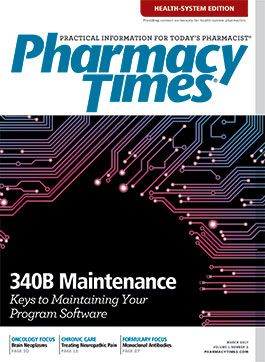Publication
Article
Pharmacy Practice in Focus: Health Systems
The One that Broke the Camel's Back: DIR Fees Set to Catalyze Transparency Discussion With a Wider Audience
Pharmacy benefit managers (PBMs) play an important and necessary role within our private health care system.
DIR FEES: THE LATEST IN A LONG LINE OF SPREAD STRATEGIES
Pharmacy benefit managers (PBMs) play an important and necessary role within our private health care system. Because there is no central authority to set prices for drugs, PBMs step in to create a marketplace (of sorts) for buyers and sellers. They also provide administrative functions, such as adjudicating claims and writing checks on behalf of payers. PBMs handle billions of transactions a year, ostensibly to generate operating revenue. However, these transactions are largely a commodity. So to supplement that revenue, spread strategies need to be employed. Spread occurs when a portion of the buy—sell difference can be retained by a PBM. This is akin to the house’s take in a casino (except without knowing the percentage “take”). Direct and indirect remuneration (DIR) fees are the latest in a long line of reimbursement strategies that rely on spread and generate margin for PBMs.
TRANSPARENCY IS THE KRYPTONITE OF ANY SPREAD BUSINESS
Squeezing one end of the proverbial margin balloon results in the other end getting bigger. In the case of DIR fees, the federal government wanted a clearer view into the spread and to receive a bigger part of that spread. Thus, the payer side of the balloon got squeezed. As a result, community pharmacies, by and large, ended up rebalancing the air in the balloon on the other side through DIR fees, which are simply a way to package the PBM margin in another way and place the burden of that spread on the pharmacy. The package may include network access fees, performance tiering, and other attributions of apportionment. It can be anything that is assigned to the total dollar amount. This strategy is only possible (politically or otherwise) through lack of transparency in the clawback provisions. Although good at generating profit, lack of transparency is an anathema to properly functioning marketplaces. Remember collateralized debt obligations and the financial crisis? Nobody had any idea what was in those packaged debt vehicles; not the buyers or sellers, just the people who created them.
NO LONGER INSIDE BASEBALL: THE TRANSPARENCY DISCUSSION GOES MAINSTREAM
Advocating for transparency in pharmacy reimbursement can be challenging since conversation typically comes across as esoteric, with discussions involving highly technical rebate structures and multiple layers of interested parties. There is general lack of fanfare surrounding the issue despite the best efforts of pharmacies, as the average individual finds it difficult to understand or to attach to emotionally. However, several catalyzers are now in play that are rapidly changing that dynamic and widening the aperture of the discussion to include mainstream policymakers and media channels.
CATALYZER #1: DIR FEES WERE BORN OUT OF REGULATION TO CREATE TRANSPARENCY FOR THE FEDERAL GOVERNMENT
Anytime a program that involves government is implemented, it is ultimately subject to public scrutiny, open forums, and disclosure. Avenues to engage, if you are a patient advocate or a provider advocate, are much more plentiful. DIR fees (and ultimately, spread itself) will likely be the issue that pierces the transparency veil of all mechanisms that create spread because the rules and procedures around government make the discussion hard to hide.
CATALYZER #2: DIR FEES REQUIRE OPACITY TO GENERATE MARGIN
Spread margin is an animal of opacity. In a transparent environment, margin is generated as a fee (not spread). DIR fees require opacity to exist. The country’s mood is currently not favorable toward the person behind the curtain pulling the strings but not willing to come out and show his cards.
CATALYZER #3: DIR FEES AFFECT THE CONSUMER
Recent reporting has uncovered ways in which DIR fees may affect consumers and their out-of-pocket spend. That is a significant shift in tact that will broaden the audience of the interested.
CATALYZER #4: PRESIDENT TRUMP’S POPULIST STANCE ON DRUG COSTS
This one is the kicker. For years, pharmacies and Pharmaceutical Research and Manufacturers of America (PhRMA) have been at odds during budget season because both contribute to the total cost of drugs, fighting between therapeutic interchange and pharmacy reimbursement reductions as competing ways to accommodate drug budget cuts. However, as PhRMA and pharmacies have been squeezed over time, the portion of available margin going to these 2 stakeholders has come more in line per transaction with PBM spread. This has had the effect of bringing otherwise warring parties closer together to spotlight the PBM industry’s role as part of the drug cost driver equation (which is the opposite of its intended market purpose). The fact that a Republican is proposing price controls will shine a $300 billion-watt bulb on how drugs are purchased and reimbursed through the entire value chain.
CATALYZER #5: LEGISLATION (REGARDLESS OF OUTCOMES)
No proposed or introduced legislation is worth a darn unless it has broad political momentum behind it. Legislators can introduce legislation all session long that gets referred to committee, with no hearings or momentum. However, because of catalyzers 1 through 4 above, House Resolution 1038 and Senate Bill 413, which speak to transparency, now have legs. And even if they never reach a vote, they will no doubt have a much wider audience, and that is a game changer.
TROY TRYGSTAD, PHARMD, PHD, MBA, is vice president of Pharmacy Programs for Community Care of North Carolina, which works collaboratively with more than 1800 medical practices to serve more than 1.6 million Medicaid, Medicare, commercially insured, and uninsured patients. He received his PharmD and MBA degrees from Drake University and a PhD in pharmaceutical outcomes and policy from the University of North Carolina. He also serves on the board of directors for the American Pharmacists Association Foundation.







